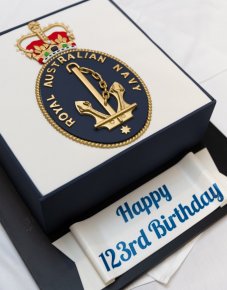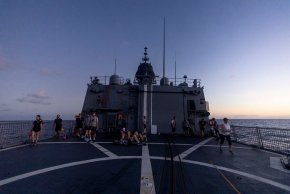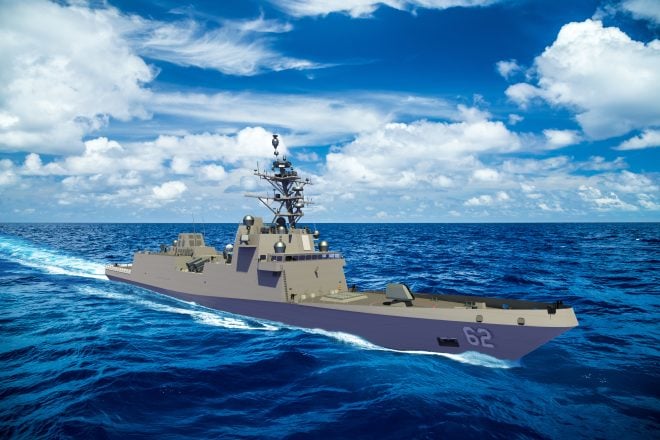There is clearly a range of views about the role and armament of the Tier 2 frigates and I think that debate is healthy, as long as it remains courteous. I'm sorry (but not really sorry) that I seem to keep harping on about courtesy, but the discourtesy that seems to be a feature of online discourse these days is quite sickening to me - I abide by the philosophy, "If you wouldn't say it face-to-face, don't say it online!".
There have also been some comments about a possible split build for the Tier 2 frigates, and that is a very interesting proposition.
I will make no bones about it - I am strongly in favour of the Mogami/new FFM as the RAN Tier 2 frigate. I think there is a great to like about these ships, and I think this class(es) of ships has the potential to be both a short-term and long-term boon for the RAN in terms of its low crewing numbers and the range of tasks it can undertake. As I said in a previous post, if I was 20 years younger, I would leap at the chance to serve aboard a Batch 1 or "new FFM"/Batch 2 Mogami-class frigate in the RAN.
With regard to a possible split-build, if the Mogami-class was to be chosen as the RAN's preferred design, from what I have read since my original post on the topic (#8,366), the build of the Batch 1 Mogami-class frigates for the JMSDF may actually have been slowed somewhat - the reasons aren't entirely clear to me, but I suspect it may be to keep the existing Mogami-class build ticking along until the design of the "new FFM" or what I have described as the Batch 2 Mogami-class frigate is settled and ready to start construction. This maintenance of "hot""or at least "warm" production lines seems to be a feature of both Japanese and Korean naval ship-building, which clearly is a priority for the governments of both countries. If only Australian governments had adhered to the same philosophy and avoided "valleys of death", the RAN's current woes could have been avoided - alas, successive governments chose to do nothing instead.
Currently the start of the new FFM/Batch 2 Mogami-class build appears to be likely to start in 2027.
That could give a small window from mid to late 2025 until 2027 between the end of the current Batch 1 Mogami-class frigate build and the start of the new FFM/Batch 2 Mogami-class build. It seems possible that in the small window between the end of the Batch 1 and the start of the Batch 2 builds, Australia could request the "crash-build" of three basic Batch-1 Mogami-class ships to the extent of the hulls, propulsion and power-generation machinery and superstructure (say up to bridge-level), with spaces left for installations of the necessary cables, wiring and cooling for CEAFAR, Saab 9LV, etc. The hulls could then be sea-lifted to Australia (as the LHDs were) for an Australianised fitout to be completed here. That would allow for the installation of CEAFAR, Saab 9LV, Nulka and MASS decoys, and other RAN systems and weapons. The 16-cell Mk-41 VLS could be installed either in the "crash-build" process or as part of the Australian fitout - whichever option would be most efficient (I suspect the latter, but am happy to be corrected).
The result would be something of a "Franken-frigate" for the first three overseas-built vessels, with RAN weapons and sensors inserted into or bolted onto a Batch 1 Mogami-class hull. These ships could represent an advance in capability over the Anzac-class ships, which could be replaced on a one-for-one basis as each new Batch 1 Mogami-class frigate enters service. It would be a moderate- to high-risk approach, but speed to IOC and FOC could be crucial if the Commonwealth is really serious about getting replacements for the Anzac-class into the water in the timeframes outlined in the current government's announcement (first steel cut in 2026, and the first three Tier 2 ships in service by the time the first Hunter-class frigate enters service in 2034).
That would leave the potential for the remaining 8 Tier 2 frigates to be constructed in Australia to a different design. If what I have outlined were to be decided upon by the Commonwealth, then if selected the "new FFM"/Batch 2 Mogami-class design, which is larger and more capable than the Batch 1 design, with Australianisations, could start construction at Henderson from around 2030, which would allow Australia to benefit from the learnings of Mitsubishi Heavy Industries from the construction of the first few "new FFM"/Batch 2 Mogami-class ships for the JMSDF.
Of course, I'm just a former PWO, and a great big nerd - I am quite happy to defer to the expertise of those members who have actual shipbuilding experience.
Do you think I might be on the right track, or am I way off the mark?









